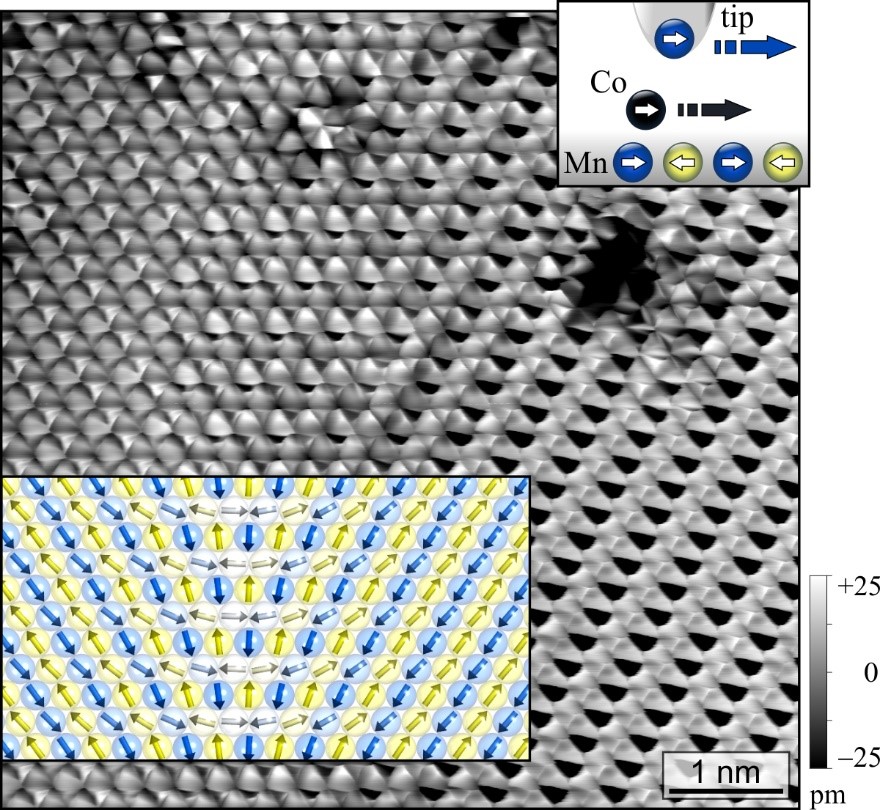Press release
A new type of antiferromagnetic domain wall
As reported in the journal Nature Communications, a team of physicists at the University of Hamburg discovered a new type of magnetic domain wall in a single atomic layer of manganese. Domain walls are boundaries between different homogeneous regions of a magnetically ordered material. The domain walls observed in this new study occur in an antiferromagnetic (AFM) material, i.e. atomic magnetic moments prefer an antiparallel alignment. They have a width of about 2 nm only and show a characteristic spin texture with unique properties, distinct in several ways from the adjacent row-wise AFM domains. Surprisingly, these wall types have not been anticipated theoretically. We expect that this new AFM wall type can also be found in other systems where the symmetry of the AFM spin texture is lower than the hosting crystal lattice.
AFM spintronics is an expanding new field in condensed matter research which has emerged from the desire to exploit the unique properties of AFM materials for technological applications. Key AFM features are fast dynamics, potentially large magneto-transport effects and an intrinsic robustness against perturbing external magnetic fields. While progress has been made on many fronts, AFM materials are notoriously difficult to investigate due to their vanishing net magnetization. In particular, while a number of experimental techniques have been developed to image AFM domains and domain wall positions, determining AFM wall widths and their internal spin configuration remains challenging.
In the present study, domain walls in a single atomic Mn layer on a Rhenium(0001) single-crystal substrate were investigated, combining spin-polarized STM, atom manipulation, and spin dynamics simulations. The row-wise AFM state allows for three symmetry equivalent rotational domains within the hexagonal Mn layer, two of which are imaged in Fig. 1. Since the usual coherent spin rotation between domains is in this case forbidden by symmetry, the domain walls show a characteristic spin texture with 90° angles, in contrast to the collinear row-wise AFM domains. This allows domain wall imaging with non-magnetic STM tips and should lead to distinct interactions of domain walls with lateral currents which might be exploited for AFM spintronics applications. Mathematically the domain wall state can be constructed as a superposition of the two adjacent domains. Surprisingly, the domain wall width is independent of the crystal anisotropy, but instead is governed by a balance of Heisenberg and higher-order exchange interactions. As a proof of principle, we have also demonstrated that these domain walls can be moved by manipulating individual adsorbed atoms - both magnetic and non-magnetic - opening new possibilities to tailor AFM spin configurations.

Figure 1: New type of domain wall in a row-wise antiferromagnet. Magnetic atom manipulation image measured on a hexagonal manganese monolayer on Re(0001): a single Co atom which follows the moving STM tip at all times is used as local sensor and amplifier of the atomic lattice and spin configuration, see upper inset. The domain wall (see simulated spin configuration) shows a non-collinear spin texture with unique properties, distinct from the adjacent collinear rotational domains. (Measurement parameters: U = +3.8 mV, I = 60 nA, T = 4.2 K, Cr tip).
Image: UHH/MIN/Kubetzka.
Original publication:
Jonas Spethmann, Martin Grünebohm, Roland Wiesendanger, Kirsten von Bergmann, and
André Kubetzka,
Discovery and characterization of a new type of domain wall in a row-wise antiferromagnet
Nature Communications 12, 3488 (2021).
DOI: 10.1038/s41467-021-23760-2
Further Information:
Dr. André Kubetzka
Department of Physics
University of Hamburg
Jungiusstr. 11
20355 Hamburg
Phone: 040 / 42838-7976
E-Mail: kubetzka@physnet.uni-hamburg.de
